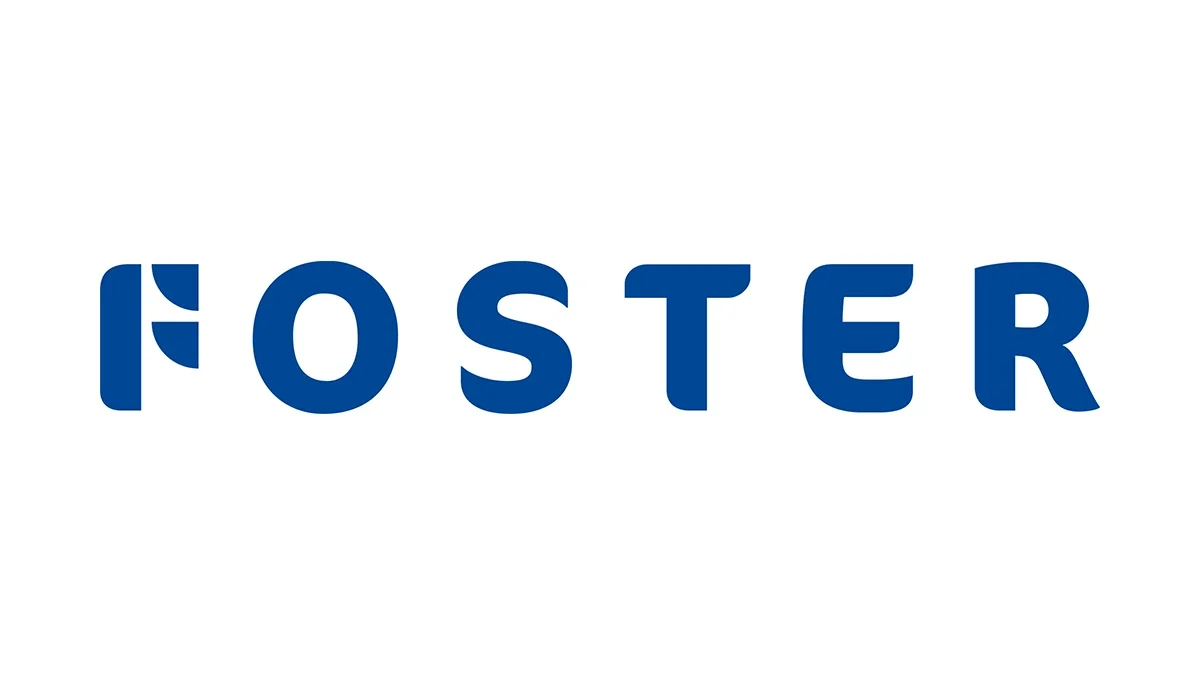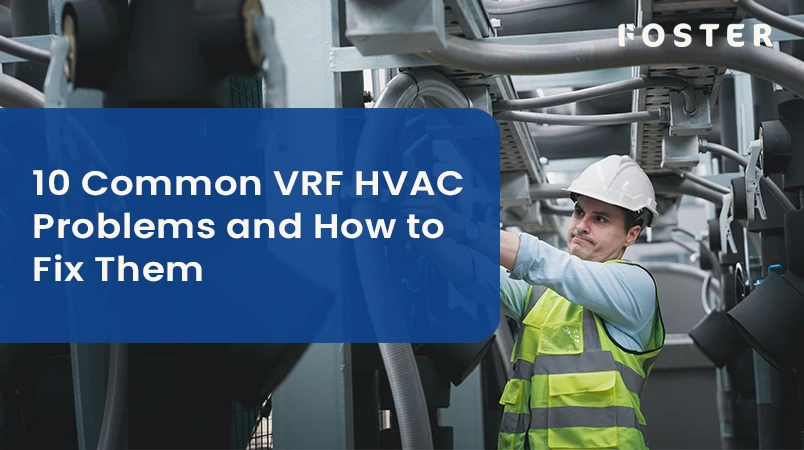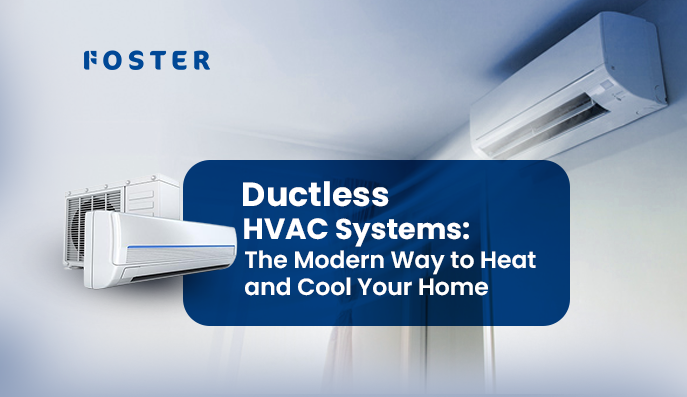A VRF (Variable Refrigerant Flow) HVAC system utilizes refrigerant for both cooling and heating, adjusting the flow to indoor units according to demand. This system enables simultaneous cooling and heating in various zones, making it a perfect option for buildings with diverse thermal requirements.
As more property owners in the UAE prioritize energy efficiency and adaptable comfort, VRF systems have emerged as a leading choice. However, certain VRF HVAC issues may occur without proper upkeep. In this guide, we’ll walk you through the most common VRF HVAC problems, share a step-by-step troubleshooting guide, and explain when to seek professional VRF repair.
Here is a list of 10 most common VRF problems:
- Inconsistent Cooling Across Zones
- VRF System Not Cooling Properly
- System Failing to Turn On
- Recurrent VRF Error Codes
- VRF Compressor Failure
- Indoor-Outdoor Communication Failures
- System Lockouts and Frequent Resets
- Abnormal Noise and Vibration
- System Freezing or Overheating
- Unexpected Spikes in Energy Consumption
Common VRF HVAC Problems in Commercial Settings
- Inconsistent Cooling Across Zones
In commercial properties using VRF systems, it’s common for different zones to experience varying temperatures. This may result from misconfigured zoning logic, faulty indoor sensors, or imbalanced refrigerant flow. Learn how proper zoning system design enhances indoor comfort and efficiency. - VRF System Not Cooling Properly
When your VRF system isn’t delivering the expected cooling output, the issue might lie in dirty filters, clogged or corroded coils, low refrigerant levels, or faulty expansion valves. This is especially relevant in high-use commercial settings where system strain is constant. Performing regular coil cleaning can dramatically improve heat transfer efficiency—refer to our step-by-step coil cleaning guide. - System Failing to Turn On
This problem often stems from tripped breakers, controller malfunctions, or internal lockout protections. For facility managers, ensuring an uninterrupted power supply and correctly functioning thermostats is the first step. Familiarity with core HVAC services can help determine the right support required. - Recurrent VRF Error Codes
Codes like E6 (compressor failure), P4 (inverter module overheat), or U4 (communication failure) require specialized knowledge. Learn why choosing the right HVAC contractor is critical for error code diagnosis. - VRF Compressor Failure
Compressors are central to system functionality and are prone to issues from voltage fluctuations, overheating, or oil return problems. While some issues may be repairable, many cases lead to full compressor replacement.For industrial use, scroll compressors are often a reliable alternative. - Indoor-Outdoor Communication Failures
VRF systems rely on digital communication between indoor and outdoor units. Faulty communication wiring, address conflicts, or controller errors can cause units to drop offline. These failures are disruptive in environments like hospitals, hotels, or office complexes where continuous climate control is non-negotiable. - System Lockouts and Frequent Resets
Systems that reset often are likely facing unresolved internal faults or overheating. If this becomes routine, it’s a clear sign that your building requires structured maintenance support. Investing in a comprehensive HVAC maintenance contract can help prevent such disruptions. - Abnormal Noise and Vibration
While VRF systems are known for their quiet operation, strange sounds like buzzing, knocking, or vibration often signal mechanical imbalance or airflow blockage. - System Freezing or Overheating
Areas with high heat and dust levels place extra strain on HVAC equipment. Outdoor units often overheat due to restricted airflow or sand buildup, while indoor units may freeze due to low refrigerant or airflow issues. This highlights the critical need for climate-specific maintenance. Our guide on why HVAC maintenance is essential offers strategies to mitigate such issues. - Unexpected Spikes in Energy Consumption
Increase in energy bills rise without an increase in usage indicates VRF system may be running inefficiently due to refrigerant leaks, malfunctioning sensors, or aging components. In peak summer periods, temporary AC rental solutions may provide interim relief while repairs are underway.
For a detailed breakdown of how this technology works, read our guide on how VRF systems function.
VRF Error Codes You Need to Know
Here are some common VRF error codes you may encounter:
| Error Code | Meaning | Brands Affected |
| E6 | Compressor lock or failure | Daikin, LG |
| P4 | Inverter module overheating | LG, Mitsubishi |
| U4 | Communication failure between units | Mitsubishi Electric |
| E1 | Indoor unit sensor error | General use |
Tip: Always consult your system’s manual or contact a VRF technician to decode these messages properly.
Step-by-Step VRF HVAC Troubleshooting Guide for Facility Teams
Troubleshooting a VRF system in a commercial environment requires a methodical and brand-specific approach. Technicians follow these essential steps to isolate and resolve issues efficiently:
- Verify Electrical Supply and System Controls
Check all power sources, including breakers, isolators, and system controllers. Power inconsistencies or lockout conditions are often at the root of non-starting systems. - Assess Airflow and Filter Condition
Clogged filters and restricted airflow significantly affect system output. Filters and return vents should be inspected and cleaned regularly, especially in dust-heavy regions. - Interpret Error Codes Accurately
Using diagnostic tools or system interfaces, extract and decode any active fault codes. Common examples include E6 (compressor failure), P4 (inverter overheat), and U4 (communication error)—reference manufacturer’s documentation for specifics. - Inspect Communication and Sensor Inputs
Evaluate indoor-to-outdoor unit communication, sensor calibration, and control wiring for faults or disconnections that may disrupt operations. - Initiate Expert-Level Diagnostics if Needed
If base-level checks do not resolve the issue, escalate to certified technicians equipped with brand-specific tools and access to proprietary VRF component data.
If you’re planning a new VRF installation, our professional VRF system installation guide outlines every stage of the process. Also discover why choosing the right HVAC contractor is critical for complex system issues like VRF.
VRF HVAC Pros and Cons: Is It the Right Choice for Your Building?
Even with their complexity, VRF systems are widely chosen for a reason.
Pros:
- Precise zoning control
- Energy-efficient operation
- Quiet and compact units
Cons:
- High upfront cost
- Complex components require specialized servicing
- Error codes and diagnostics often need expert interpretation
Conclusion: Trust Foster International for Expert VRF HVAC Support
VRF HVAC systems deliver efficient, precise climate control but require specialized maintenance to avoid costly downtime. For commercial properties, it is essential to recognize common issues early and work with experienced professionals.
Foster International offers expert VRF diagnostics, repairs, and maintenance tailored to the UAE’s unique climate and building needs. Partner with us to ensure your VRF system runs smoothly, maximizing comfort and operational efficiency year-round.



 Previous Post
Previous Post

